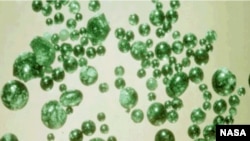Water on the moon came from the same source thought to have supplied most of the water on Earth, according to new research published in the journal Science. The common origin offers new insights into how planets formed and evolved.
Scientists have long believed our Moon was formed when a Mars-size planet collided with the Earth 4.5 billion years ago and jettisoned a disk of molten debris into space. The cataclysm would have generated enough heat on the newborn Moon to burn off the elements needed to form water, leaving it bone dry.
But in a series of papers over the past five years, Brown University geochemist Alberto Saal and his colleagues have been telling another story. Using new instruments, they re-examined samples of lunar rocks collected by astronauts on the Apollo Moon-landing missions in the early 1970s.
“We found the first evidence (of) the components of water in lunar volcanic rocks. And these volcanic rocks come from the interior of the Moon, therefore the interior of the moon should have the components that will form water.”
In 2011, they reported that the chemical signatures of water trapped in the ancient lunar rocks matched those found in rocks from the interior of the Earth.
“Therefore we thought that somehow the water that is in the Moon is related to the water we see on Earth. They have the same type of origin. They came from the same type of reservoir. So the question came up of where the water came from, and how the water got to the Moon,” said Saal.
As much as 98 percent of the water on the young Earth is believed to have come from ice-bearing meteorites - debris from the formation of the solar system that rained down on the still-cooling planet 4.5 billion years ago.
“Essentially the Earth when it formed, formed with water by the coalescence of these very early solid materials that formed from the solar nebulae," said Saal.
Saal believes some of that water was transported with the new Moon during its birth in that cataclysmic collision.
“Somehow, we don’t know how exactly, but somehow part of that water was not completely evaporated into vacuum, but some of that water went to the Moon,” he said.
Saal’s research helps explain how terrestrial planets like Earth, Venus, Mars and Mercury formed. Prior to evidence of water on the Moon, there was no reason to suspect that these planets would have had water when they formed. Saal says while Earth is a dynamic evolving system, the Moon is a fossilized record of our planet’s origins.
“By looking at the Moon and [seeing] that the rocks on the moon have water and that that water looks very similar to Earth that gives us the indication that the water on Earth came very, very early and probably most likely the Earth formed with water,” he said.
Saal plans to analyze more Moon samples to confirm the findings, which may reveal more details about the events that formed the Moon, and its link to early Earth.
Scientists have long believed our Moon was formed when a Mars-size planet collided with the Earth 4.5 billion years ago and jettisoned a disk of molten debris into space. The cataclysm would have generated enough heat on the newborn Moon to burn off the elements needed to form water, leaving it bone dry.
But in a series of papers over the past five years, Brown University geochemist Alberto Saal and his colleagues have been telling another story. Using new instruments, they re-examined samples of lunar rocks collected by astronauts on the Apollo Moon-landing missions in the early 1970s.
“We found the first evidence (of) the components of water in lunar volcanic rocks. And these volcanic rocks come from the interior of the Moon, therefore the interior of the moon should have the components that will form water.”
In 2011, they reported that the chemical signatures of water trapped in the ancient lunar rocks matched those found in rocks from the interior of the Earth.
“Therefore we thought that somehow the water that is in the Moon is related to the water we see on Earth. They have the same type of origin. They came from the same type of reservoir. So the question came up of where the water came from, and how the water got to the Moon,” said Saal.
As much as 98 percent of the water on the young Earth is believed to have come from ice-bearing meteorites - debris from the formation of the solar system that rained down on the still-cooling planet 4.5 billion years ago.
“Essentially the Earth when it formed, formed with water by the coalescence of these very early solid materials that formed from the solar nebulae," said Saal.
Saal believes some of that water was transported with the new Moon during its birth in that cataclysmic collision.
“Somehow, we don’t know how exactly, but somehow part of that water was not completely evaporated into vacuum, but some of that water went to the Moon,” he said.
Saal’s research helps explain how terrestrial planets like Earth, Venus, Mars and Mercury formed. Prior to evidence of water on the Moon, there was no reason to suspect that these planets would have had water when they formed. Saal says while Earth is a dynamic evolving system, the Moon is a fossilized record of our planet’s origins.
“By looking at the Moon and [seeing] that the rocks on the moon have water and that that water looks very similar to Earth that gives us the indication that the water on Earth came very, very early and probably most likely the Earth formed with water,” he said.
Saal plans to analyze more Moon samples to confirm the findings, which may reveal more details about the events that formed the Moon, and its link to early Earth.














